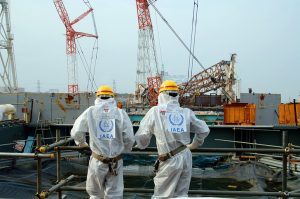The topic of our group of the group project 2 is about the population of flora and fauna in Fukushima area. Japan’s Triple Disaster has had a marked impact on fauna and flora in the Fukushima region. Reproductive capacity, population size, and overall health are a few of the plethora of measurable changes observed in local populations of both plant and animal life. It is easy to view the disaster from the scope of its economic impact or by the number of lives lost. Although these are certainly important variables to measure, it is all too easy to overlook the geographic effects of such an immense natural disaster. Entire ecosystems have been drastically changed, and it is unclear if they can or will ever return to their pre-disaster equilibriums. The change of the physical topography of the region, coupled with radiation contamination has transformed modern geographic and ecological understandings of the Fukushima region. Much work must be done to reclaim this land, and further research must be executed to understand the viability of such a grand reclamation process.

https://assets.rbl.ms/6433781/980x.jpg

http://sites.suffolk.edu/arajchel/files/2012/01/japan_quake_0407_02.jpg
We all know the power of nuclear energy, just likes a coin, everything has its dual character. I am more concerned about those people who affected by this accident.
Nuclear energy has many advantages as a cost-effective measure to mitigate the world’s energy crisis. First, it has the great power of the small volume. The nuclear energy is millions of times larger than chemical energy. Second is less pollution. Nuclear power plants have set up layers of barriers that basically do not emit pollutants to discharge to the environment.
However, the disadvantage of nuclear power is destructive. The biggest long-term health risk is cancer. Our body has many mechanisms to stop cancerous cells and replace damaged tissues. But, the damage caused by radiation can seriously disrupt these mechanisms in the body, thereby greatly increasing the risk of cancer. In addition, mutations in our genes are likely to occur if the body does not properly repair the chemical damage and changes that radiation causes. The degree of health damage depends on the radiant quantity. The unit measures in Sieverts, or milliSieverts (mSv). According to The International Commission on Radiological Protection (ICRP), it allows up to 500 mSv for workers in emergency situations. However, an instant dose of 100-250 mSv would be harmful to human body and increase the possibility of cancer. In April 2011, the Japan’s Nuclear Safety Commission (NSC) published that 12 PBq of Cs-137 had been released to the environment, which is the equivalent of 620 PBq of iodine-131. Moreover, 210 Sv/h also released into the air, the ground and water body.

http://japanfocus.org/data/ground_surface_radioactive_contamination1.png
Now we see the power of nuclear energy.
After this accident, 154,000 people have been replaced. Other groups in the class also talked about this humanity problem. There are 123,000 people still unsettled, living in temporary housing and away from their hometown. 80,000 people evacuated from Fukushima also remain displaced and, they also suffer the fear of nuclear radiation and other people’s isolation. People from Fukushima area have to change their name and hide their identity in order to avoid discrimination.
When I search online, a topic caught my eyes. It is Fukushima 50.
The Fukushima 50 is who voluntarily or required to stay after TEPCO evacuated more than 800 staff following the 2011 Fukushima Daiichi nuclear accident, continued to carry out emergency repairs. By March 18, the number reached 580. They were on duty in groups of 50 and took turns in and out of the factory every 10 to 15 minutes. On May 14, an emergency rescue worker at Fukushima Daiichi suddenly died of a myocardial infarction and was highly likely to be killed by nuclear radiation.

https://inhabitat.com/wp-content/blogs.dir/1/files/2013/09/Fukushima-Daiichi-2.jpg
They are all old people. Why?
Some experts said:”Although people who are exposed to high doses of radiation have a serious concern about cancer, it usually takes at least a few years to be induced and they have passed the reproductive period.”
The TEPCO said:”Not because their lives are not precious, not because they are more experienced, not because they are more skilled, but because they may be able to enjoy their old age even if they are exposed to high doses of radiation, and will not die until the cancer is induced.”

http://news.xinhuanet.com/english/2017-03/11/ChkhsmE002002_20170311_HKMFN0A001_11n.jpg

http://i.dailymail.co.uk/i/pix/2015/03/11/26864D8C00000578-2989836-image-a-86_1426087331831.jpg
What do you think?
Sometimes the dark side of society just exposed like this. Maybe it not suitable to call it the dark side of society. Because, when bad things happen, we always have to give up some people, those who have no choice.
If you have to make a choice between a moron child and a genius child, what would you do? Maybe a lot of people would choose that genius. Some people, just like a moron child, they already got a tag of “hopeless”. They are old people who only have few years in the world, they would hardly to make contributions to society, also, they may become the burden to their families. Therefore they become Fukushima 50.
They are absolutely risking their lives to do everything to keep the nuclear power plant in a safe state.

2011 a Tsunami caused one of the biggest catastrophe of the century in Fukushima, Japan.
We wanted to pay respect to the last 50 workers in the atomic power plant, which tried to prevent an atomic disaster.
On two days we painted four different themes. First, the rising sun, second the beauty of the Japanese landscape, third the cause of the disaster and at last the impact of the atomic contagion.
http://3steps.de/wp-content/gallery/fukushima-giessen-2011/3Steps-Fukushima50-2011-Step2-8.jpg
References
Comparison of Fukushima and Chernobyl nuclear accidents. (2017). Wikipedia. Retrieved from: https://en.wikipedia.org/wiki/Comparison_of_Fukushima_and_Chernobyl_nuclear_accidents
Fukushima: Radiation Exposure. (2016). World Nuclear Association. Retrieved from: http://www.world-nuclear.org/information-library/safety-and-security/safety-of-plants/appendices/fukushima-radiation-exposure.aspx
Six Years after the 3/11 Disasters. (2017). The Japan Times. Retrieved from: https://www.japantimes.co.jp/opinion/2017/03/10/editorials/six-years-311-disasters/#.WgiblbA-eRs